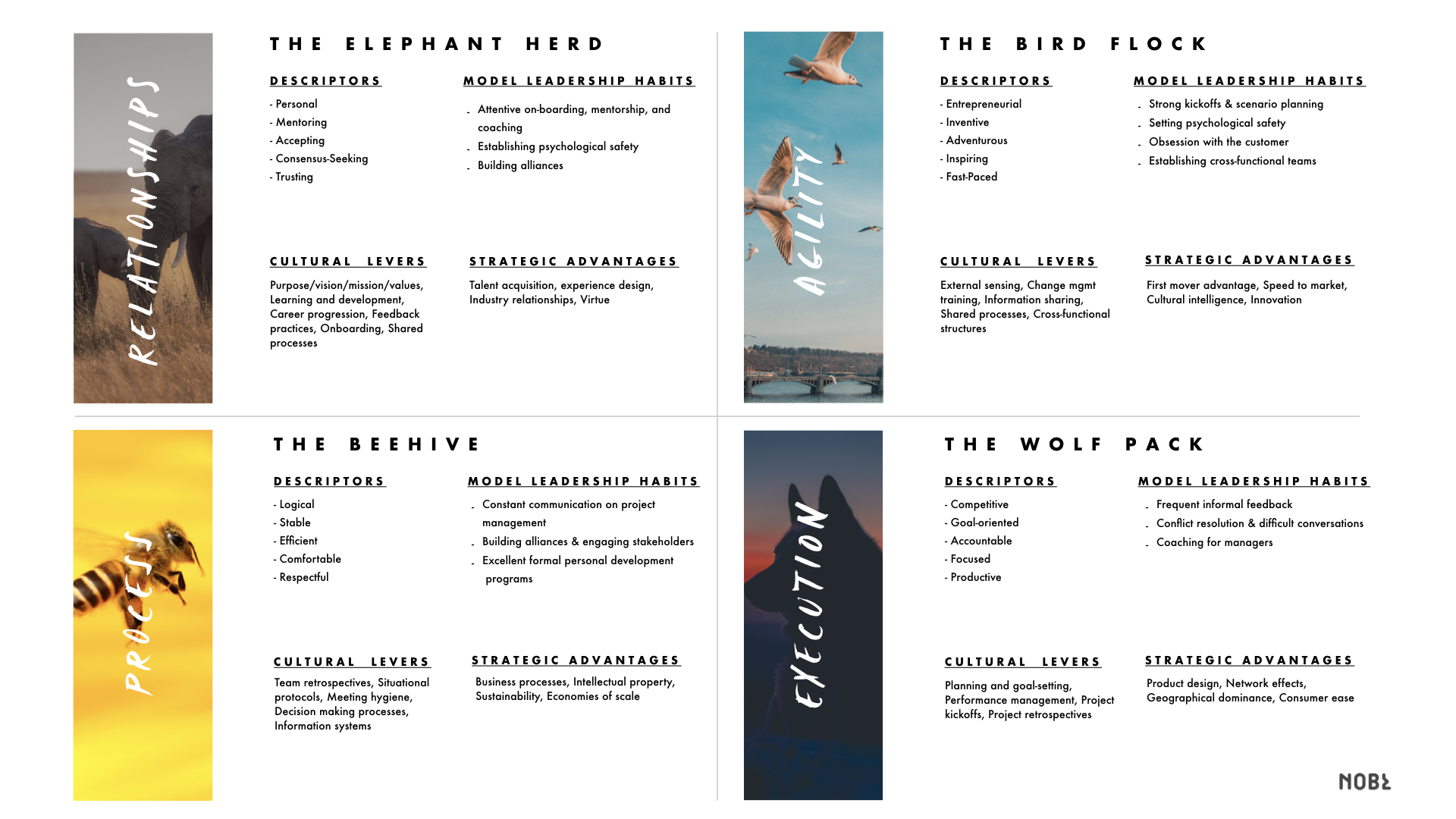If you track the conversation around the future of work, you might believe that we all should religiously follow the example of a handful of currently-successful organizations.
We should be in two-pizza-sized teams like Amazon. We should be organized in squads like Spotify. We should be ruthlessly candid to one another like Bridgewater. We should be obsessed with design as much as Apple. We should always work in sprints. Sprints, sprints, sprints. Agile, agile, agile.
In any era, the easiest thing to do, especially for a consultant, is to look at whoever is successful and tell people to copy them outright.
In any era, it’s the wrong thing to do.
Survivorship bias is a siren singing you to certain shipwreck.
We need to elevate the conversation out of mimicry and hero-worship.
The problem with the future of work conversation is that there is no single future of work. There are futures of work, plural. We believe that you can chart these futures on a spectrum from fixed to fluid.
The possibilities to reshape how we work should be as varied as our markets and customers. The possibilities to reshape how we work should be as competitive as our markets.
How we work should be aligned with our market and our strategy, not the latest business book or Harvard Business Review case study.
What we all need to find is culture/market fit.
Product/market fit was a term coined by Marc Andreesen and defined as, “being in a good market with a product that can satisfy that market.” In other words, find yourself a healthy market and develop a product that does what that market needs.
Culture/market fit is similar, yet even more foundational. Find yourself a healthy market, yes. Then develop a culture that can deliver product/market fit. Your culture is what produces your products and services. You know you have culture/market fit when both talent and customers flock to your company for who you are, even above what you make. You know you have product/market fit when legions of customers buy your product.
Without culture/market fit, sustainable product/market fit (at any size, scale, or maturity) is impossible.
For example:
- If winning in your market means delivering the most seamless customer experience, you better have a culture that values collaboration more than individual control.
- If winning in your market means understanding external cultures better than your competitors, you ought to value speed and listening above product and messaging consistency.
- If winning means elevating a tool to a work of art in both form and function, you need a culture that appreciates and values beauty and elegance even over convention.
- If winning means producing a flawless and reliable product, then you need a culture that values process even above creativity.
Rather than being a Frankenstein’s monster of the latest fads and fashions, culture/market seeks to find the essential connection between how to win in the market and how to work together. We should borrow, but we should borrow for a strategic reason.
To that end, we need a model and process for aiming for exactly what we want and need.
The Culture/Market Fit Model

We’ve spent the last six months developing a model for culture/market fit. We’ve found that there are four competing flavors of organizational culture, each with unique traits and competitive strengths:
- The Elephant Herd: these cultures value interpersonal dynamics and relationships above all else. They are described by employees as being personal, mentoring, accepting, consensus-seeking, and trusting. These cultures tend to excel at strategies such as experience/service design, talent acquisition, and virtuousness. Think Patagonia, Pixar, and Zappos.
- The Bird Flock: these cultures value agility above all else. Employees use words like entrepreneurial, inventive, adventurous, inspiring, and fast-paced to describe these workplaces. Bird flocks tend to excel at cultural intelligence, customer intelligence, and of course speed to market. Think Beats, Zara, and Netflix.
- The Beehive: these cultures value process and procedure above all else. Employees say these cultures feel logical, stable, efficient, comfortable, and respectful. Beehives often rock at achieving economies of scale, preserving intellectual property, and dominating on price. Think Toyota, GE, and Coca-Cola.
- The Wolf Pack: these cultures value execution and results above all else. Their employees use words like competitive, goal-oriented, accountable, focused, and productive to describe their workplaces. Wolf Packs can crush product design, geographical strategies, and capturing network effects. Think Facebook, Nike, and Bridgewater Associates.
When we work with clients, we help them find culture/market fit. This involves helping them diagnose 1) their current culture(s), 2) how well those cultures are attuned to deliver their strategies, and 3) how to shift their culture(s) toward an ever-better culture/market fit by experimenting with different cultural levers.
A few notes and caveats:
- These “cultural flavors” weren’t picked from a hat. They have been adapted from a robust academic model called The Competing Values Framework. That framework has given us a solid base upon which to study strategic advantages and disadvantages.
- Many companies begin with a dominant Bird Flock culture while they search for product/market fit. After all, speed is critical when resources and time are scarce. As these companies succeed and scale though, the choice of how they will change and evolve is critical to their continued success. That choice shouldn’t be driven by a leader’s temperament, it should be aligned with how they will win in their market.
- We call these “flavors” because most organizations have a mix of these at any one time. Amazon, for example, has subsidiaries that fall all over this map because Amazon is competing in many different environments which call for different strategic approaches. Moreover, a single organization likely has departments with competing values (e.g. legal for instance may value process more than the design department). In both cases, the goal isn’t to homogenize cultures into one of these flavors, it’s to ensure that these sub-cultures and microclimates can interface smoothly.
Culture/market fit is likely the critical missing step in your strategic planning process. It’s one thing to determine how you’ll compete, but without an understanding of the culture required, that strategy will always exist in a PowerPoint and not across your people’s attitudes or behaviors.
As you examine your culture/market fit, ask yourself:
- What trends or fads are you following simply because of survivorship bias or a single leader’s temperament?
- Where would you place your market on our spectrum of fixed to fluid?
- How would you describe your current culture(s) in terms of our cultural flavors?
- What culture seems critical for your current strategies? How far apart is your current culture from your desired/necessary one?
- If you’d like to make a cultural change, how can you adapt your current cultural rituals (e.g. all hands, onboarding, meetings, decision-making, etc.)?
Are you curious how your strategy and culture match or mismatch? We have a fun, interactive session we do with all new clients to help them better understand their culture and strategies. Drop us a note if you’re ready.








The Evolutionary Edge
Every Link Ever from Our Newsletter
Why Self-Organizing is So Hard
Welcome to the Era of the Empowered Employee
The Power of “What If?” and “Why Not?”
An Adaptive Approach to the Strategic Planning Process
Why Culture/Market Fit Is More Important than Product/Market Fit
Group Decision Making Model: How to Make Better Decisions as a Team